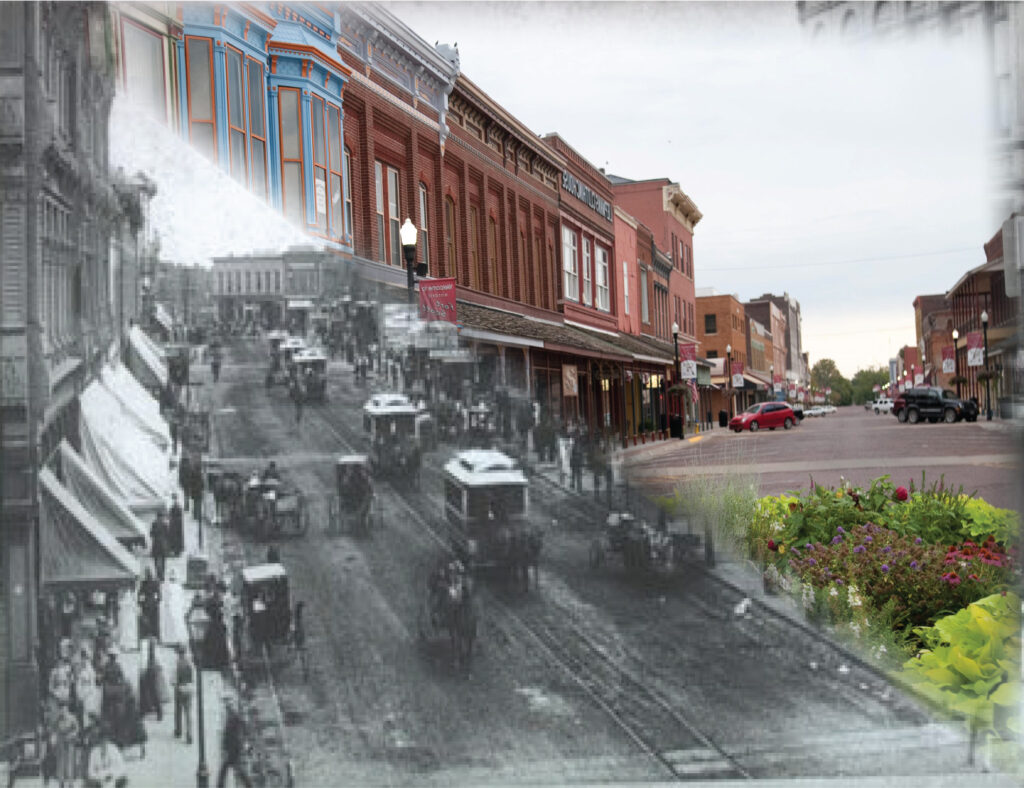Historic Downtown Fort Scott Walking Tour has many great places to experience!
MILROSE BLOCK
This corner block—known historically as the “Milrose Block”—is a representative example of early 20th-century commercial architecture in Fort Scott. Its storefronts once hosted local businesses that fueled downtown’s growth, and its masonry and design tie it to the era when Fort Scott embraced brick construction.
MCDONALD HALL
Once the home of commerce and community life, McDonald Hall is a two-story stone block that anchors Fort Scott’s downtown. As part of the National Historic Register district, it now houses The Kitchen Collective + Collaborative, a shared commercial kitchen, event space, and retail incubator.
TREMONT HOTEL / SLEEP INN
The Tremont Hotel closed its doors in 1910, and was later torn down. Now, more than 100 years later a new hotel stands in its place with a new trolley out front. Sadly not every piece of history can be saved, but in Fort Scott we continue to honor our past while embracing our future.
FORT SCOTT BRICKS
At the turn of the twentieth century, Fort Scott was home to three brick factories. These businesses produced 10,000 bricks weekly. Fort Scott bricks were used in the construction of the Indianapolis Speedway, the Panama Canal and many roads in Kansas, Missouri and Texas. Today you can see these bricks in over 14 miles of our city streets and many of our beautiful homes.
THE MO, KS & TX RAILROAD FREIGHT DEPOT
After the Civil War, Fort Scott was a premier city of the frontier, and one of the largest cities in eastern Kansas. On three different occasions, between 1870 and 1900, Fort Scott was in competition with Kansas City to become the largest railroad center west of the Mississippi. This is Fort Scott’s last remaining depot, originally built in 1870 near the Marmaton River, it was later moved from the floodplain to its current location in 1997.
SCOTTISH RITE TEMPLE
Erected in 1926, the Scottish Rite Temple was a fulcrum of fraternal and social life in Fort Scott, boasting an auditorium, dining hall, and impressive architectural details. Although the Valley of Fort Scott Scottish Rite no longer meets here, new restoration efforts are underway to revive this grand structure for future use.
MEMORIAL HALL
Dedicated to the “men and women who gave their lives serving our country in World War I,” Memorial Hall has stood as a civic landmark and gathering place. Its centennial was recently observed, and it continues to serve as a poignant reminder of local sacrifice and memory.
FORT SCOTT LIBRARY
In its present home since 1904, the Fort Scott Public Library is among Kansas’s original Carnegie libraries. Its establishment followed Eugene Ware’s 1891 donation and a citizen vote to found a free library. After a 2016–17 renovation, the library continues to serve as a modern hub for knowledge, community, and learning.
The Ohio Block/Hornaday-Howard Building was a former railroad hotel, turned historic inn, built in 1906. The original owner of the hotel placed a schooner ship on the roof after he fell in love with it during the annual Christmas Parade. Though the ship was eventually removed, the hotel still offers all the charm of the early 1900s.
The theatre once occupied what was originally built as a commercial structure,. In 1919 it opened for its first show as a single screen theater with a balcony. The Liberty has now been fully restored and is used for live entertainment and special events.
In 2005 a fire blazed through our historic downtown, destroying several century-old buildings. The Lowell Milken Center, which was previously located across the street was looking for a new facility, and this site became the perfect location for the growing museum. Now, more than 10 years later, people from all 50 states and 96 foreign countries have visited the Hall of Unsung Heroes.

